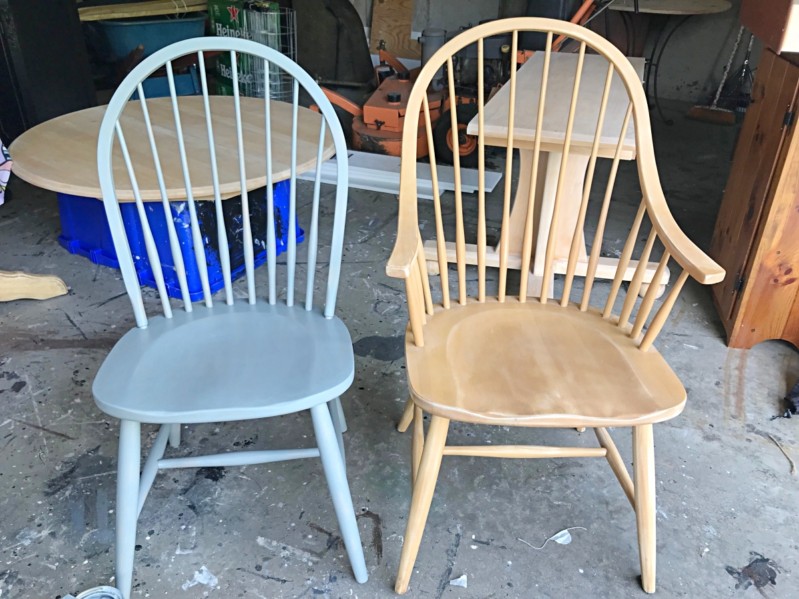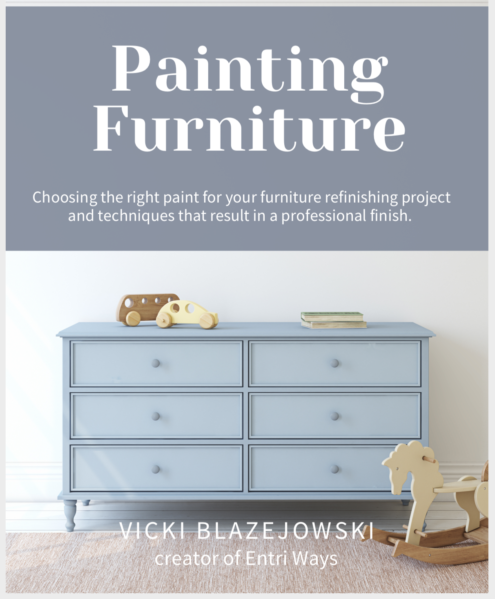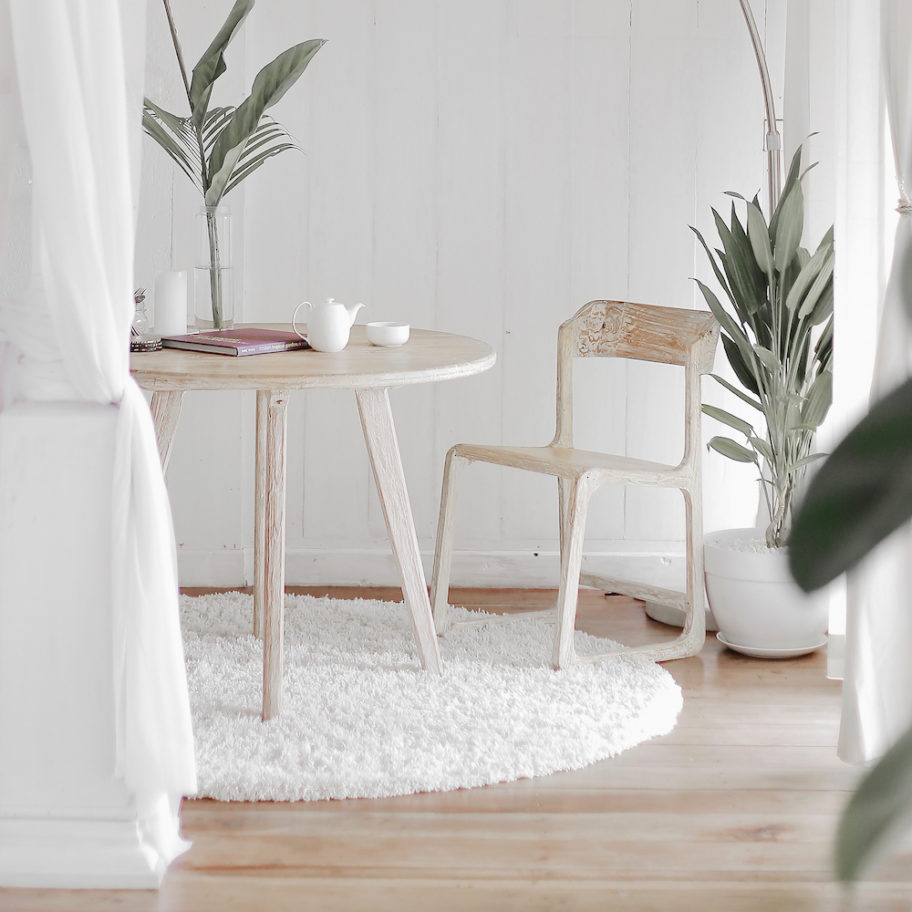When you paint as many chairs as I have, you get to know which water-based paints work best and which do not. There are some paints that do not adhere well and some that are more work to apply than others. After all the trial and error over the past several years, I’ve been able to find, in my opinion, the best water-based paint for chairs.

Maybe this post should be titled, The Second Best Paint For Chairs. Oil-based paint is actually the most durable and probably the very best choice for chairs, but with the volume of furniture I paint, I prefer to use and now most often paint with water-based paints.
.
You may have tried using spray paint on chairs. Spray paint is an oil-based paint, but it can be difficult to work with, apply unevenly, drip when applied, and it scrapes off wood fairly easy. Do not use spray paint on wood furniture.
When painting chairs, latex paints require a bonding primer, even if the paint can is labelled “paint and primer”. Trust me on this. If you were to paint a wood chair with a latex paint and then leave it out it outside, then after about a year you would be able to peel that paint off in strips. It would be like strips of plastic wallpaper peeling from the chair because the paint didn’t properly adhere to the wood.
General Finishes Milk paint is a better option than latex and you wouldn’t get the plastic-like paint peeling, but milk paint still requires a primer.
Chalk paint is advertised as the paint that “sticks to everything and does not require a primer”. I’ve painted with chalk paint many times and do not agree with these claims. It requires several coats (3-4) to get good coverage and scrapes off very easy. Chairs around a table bang against each other all the time and I think you’ll also find the paint to chip off the wood easy.
.
So what is the best paint for chairs?

.
The Best Water-Based Paint For Chairs
The best water-based paint for chairs (and benches and table bases) is acrylic enamel paint.
Enamel paint is unlike latex, milk, or chalk paint in that it hardens really quickly. It dries in about an hour and seems to be cured within a week or less. Unlike those other paints which take 30 and some 60 days to fully cure – and even after that time are still soft enough to scape off when two wood chairs bang against each other.
The enamel I use does not require a primer. The only time I use a primer with with this paint is when I’m painting a chair a light color (i.e. white) to block any bleed-through. Otherwise, this enamel paint adhere’s incredibly well.
.
.
To see the the exact brand and type of acrylic enamel paint I use, please refer to this ebook, Painting Furniture.
Here, I explain all of the different types of paint, including my go-to paints for each type of project. I also explain how to manipulate the paint to minimize brush marks.
.

These chairs were painted with a Benjamin Moore color called Stonybrook. It’s a grayish green-blue or blue-green. You can see in some photos here that it looks more blue and some it’s more gray depending on how the light was hitting it.

If you are planning to paint wood chairs to transform your dining space, enamel is an excellent choice.
You can also see this higher gloss version of this paint used in THIS post.
Disclosure: This post contains affiliate links to products I’ve used myself.





Can you use this to paint kitchen cabinets?
Yes, I used this paint on our bathroom cabinet and it worked perfectly. I suggest the semi-gloss sheen though.
What is your favorite brush to use? I have spindle chairs like the one in this post and it seems it will take forever to paint with a brush, so you think this paint would work if I used a paint sprayer?
My favorite paint brush is the Purdy Clearcut. See it on Amazon here: https://amzn.to/3AO6M1D . It’s the thinest brush I’ve found which allows for super precision. Painting spindles is laborious. I have not tried this paint with a sprayer. It does dry very quickly even when watered-down, so not sure how that will do with your sprayer.
Do you sand the chairs prior to painting with the DTM?
I use the rotary sander on the seats, but lightly hand-sand the backs and spindles.
what type of grit sandpaper do you use for hand sanding and the rotary sander?
Also, I am repainting chairs that have already been painted numerous times before by someone else.
What primer do you suggest? and if the cost is the same for paint vs primer, should I just plan on several coats of paint?
Thank you.
I’m interested in buying this but where do I get it?
You can find DTM paint at most (but unfortunately not all) Benjamin Moore retailers. Go here and search for a BM retailer near you… https://www.benjaminmoore.com/en-us/store-locator?q=01801#retail-search-input
Hi there! I just did one of my chairs with the DTM low lustre. I did a light sand to get off any gloss, did a wipe down to make sure it was clean and then painted with a small foam roller. It has a bumpy finish now and not anything like I was expecting. What did I do wrong? I’m going to sand it down so it’s smooth again, but I have 3 more chairs to paint. I’d appreciate any feedback!
Tara, I’m really sorry to hear you had these results. I never use foam rollers. I find they do leave a “cottage cheese” finish. I always use a very thin angled brush. This Purdy brush: https://amzn.to/2Z1A9Ae. It also helps if you water-down the paint by 10% and apply in 2-3 thin coats, allowing it to fully dry between coats.
Thank you so much! I’ve just sanded it down smooth and I’ll grab some brushes and try again with thinning it! Thanks for replying so quickly!
Please let ud know how it works out.
I painted a bench with Benjamin Moore Advance semi gloss paint. I sanded, primed it with STX Benhamin Moore, then painted it with 2 coats of Advance. I thought I caught buy a cushion for the bench but since it is over 50 years old, the seat is 15 inches deep and all cushion are 18 or 19 inches deep. So here is the problem- I am finding the seat is getting fine scratch marks and I also worry about chipping. Can I or should I paint the bench with the DTM gloss to be sure it will not chip or show scratch marks from pants etc? If I do repaint it, do I have to sand or just paint with the DTM? Also I am going to paint an entrance metal door which has already been painted. Do I prime the door, sand the door, quickly or just paint over the painted door? Also Is the DTM paint necessary on the door. Appreciate any help I can get and also should I use a roller on the door if using DTM?
Thanks Helen
The Advance paint levels out really nicely but I think it may be better for vertical surfaces. You should be able to paint right over the Advance. Lightly sanding to create some tooth is a good idea. I have used DMT on doors or an exterior paint is fine.
I’m so glad I found your site. I just bought four wooden chairs, all have a poly surface. I plan to lightly sand, as you suggested, but since I’m painting the chairs white, which primer to you suggest to use with DTM paint, low luster.
Catarina, So glad you’re here. Any primer will work, but a shellac primer does the best job of preventing bleed-through.
Hi- I have 4 wood chairs I wanted to paint black. Do I have to sand them if they have a gloss finish or can I just paint them?
It’s a good idea to at least lightly sand a glossy finish to knock down the gloss and create some tooth for the paint to stick to.
Do you put on a coat of poly on at the end??
Margeret, A topcoat is not necessary with enamel paint, unless you prefer a higher sheen.
Can I use enamel paint on previously painted chairs?
I have had success using enamel paint over many different products, including repainting over enamel paint.
The article at the link says you used BM acrylic satin finish. I was wondering about the metal adherent paint you used on the projects in that article.
Mary, sorry about the confusion. You can view the exact paints I use within each brand in this ebook: https://entriways.com/painting-furniture/.
Refer to the page on Acrylic Enamel and follow the tips on manipulating the paint to minimize brush marks. This is the paint I used on my own bathroom cabinet; although I would suggest sanding any glossy finishes off a bit more than I did.
As an alternative, refer to the oil-enriched enamel page. This paint also works very well on cabinets.